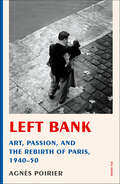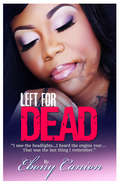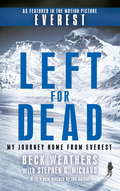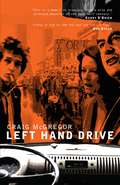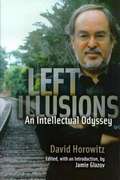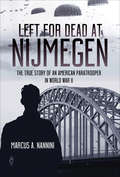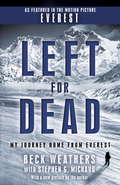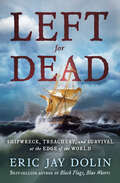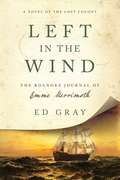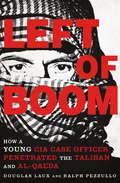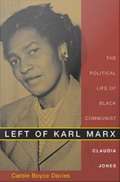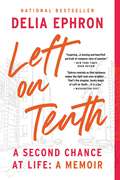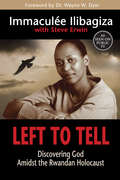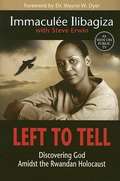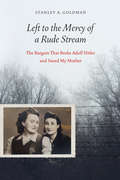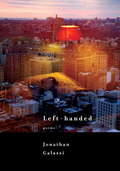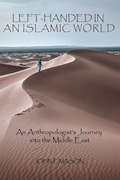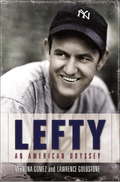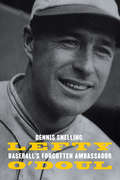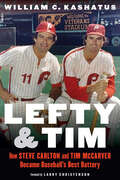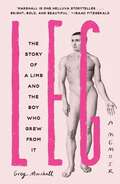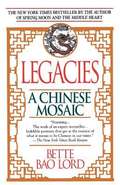- Table View
- List View
Left Bank: Art, Passion, and the Rebirth of Paris, 1940–50
by Agnès PoirierAn incandescent group portrait of the midcentury artists and thinkers whose lives, loves, collaborations, and passions were forged against the wartime destruction and postwar rebirth of ParisIn this fascinating tour of a celebrated city during one of its most trying, significant, and ultimately triumphant eras, Agnes Poirier unspools the stories of the poets, writers, painters, and philosophers whose lives collided to extraordinary effect between 1940 and 1950. She gives us the human drama behind some of the most celebrated works of the 20th century, from Richard Wright’s Native Son, Simone de Beauvoir's The Second Sex, and James Baldwin's Giovanni's Room to Samuel Beckett's Waiting for Godot and Saul Bellow's Augie March, along with the origin stories of now legendary movements, from Existentialism to the Theatre of the Absurd, New Journalism, bebop, and French feminism.We follow Arthur Koestler and Norman Mailer as young men, peek inside Picasso’s studio, and trail the twists of Camus's Sartre's, and Beauvoir’s epic love stories. We witness the births and deaths of newspapers and literary journals and peer through keyholes to see the first kisses and last nights of many ill-advised bedfellows. At every turn, Poirier deftly hones in on the most compelling and colorful history, without undermining the crucial significance of the era. She brings to life the flawed, visionary Parisians who fell in love and out of it, who infuriated and inspired one another, all while reconfiguring the world's political, intellectual, and creative landscapes. With its balance of clear-eyed historical narrative and irresistible anecdotal charm, Left Bank transports readers to a Paris teeming with passion, drama, and life.
Left For Dead
by Ebony CanionImagine having your innocence stolen at an early age by someone you trust, or struggling financially before even knowing the meaning of the word "struggling". Ebony Canion has had her share of tumultuous events, yet even she was stunned when a speeding car hit her intentionally, dragging her through the streets with her body folded underneath the vehicle. In a coma for nearly two months, Ebony had no idea her tongue and face had to be sewn back on, or the list of thirty other life-threatening injuries she had sustained. Ebony didn't know she'd been "Left for Dead". In this horrifying first-hand account of a survivor, Ms. Canion delivers a riveting story about overcoming tragedy throughout her childhood, and developing the will to live after numerous attacks on her life. Her strength to learn to walk, talk, and eat again will leave you spellbound and inspired. Her scars tell a story that must be heard and will have you never wanting to complain again.
Left For Dead: My Journey Home from Everest
by Beck WeathersAnyone who has read Jon Krakauer's famous account of the 1996 Everest disaster, INTO THIN AIR, will remember the story of Beck Weathers: the gregarious Texan climber who went snow-blind in the Death Zone below the summit and who spent a night out in the open during a blizzard that took the lives of a dozen colleagues and friends.Even as he staggered back into Camp 4 the next morning, Beck's condition was such that the other survivors assumed he would not make it back down the mountain. He was effectively left for dead, but drawing upon reserves of determination and courage he didn't know he had - as well as the extraordinary selflessness and bravery of a Nepalese helicopter pilot he'd never met - he finally made it to safety. Only then could a new battle begin: to rebuild his life with a family he'd taken for granted for too long.Heartstoppingly exciting and ultimately very moving, LEFT FOR DEAD is a terrific read.
Left For Dead: My Journey Home from Everest
by Dr Beck WeathersAnyone who has read Jon Krakauer's famous account of the 1996 Everest disaster, INTO THIN AIR, will remember the story of Beck Weathers: the gregarious Texan climber who went snow-blind in the Death Zone below the summit and who spent a night out in the open during a blizzard that took the lives of a dozen colleagues and friends.Even as he staggered back into Camp 4 the next morning, Beck's condition was such that the other survivors assumed he would not make it back down the mountain. He was effectively left for dead, but drawing upon reserves of determination and courage he didn't know he had - as well as the extraordinary selflessness and bravery of a Nepalese helicopter pilot he'd never met - he finally made it to safety. Only then could a new battle begin: to rebuild his life with a family he'd taken for granted for too long.Heartstoppingly exciting and ultimately very moving, LEFT FOR DEAD is a terrific read.
Left Hand Drive
by Craig McgregorCraig McGregor has spent his working life holding a mirror to Australian society. In Left Hand Drive, he reflects on his personal journey, writing about and living through some of the most compelling and defining events of modern times. From meeting his lifelong partner on a legendary ban-the-bomb march in the UK, listening to the unreleased Blonde on Blonde with an 'attentive' Bob Dylan, and following the twists and turns of Canberra's corridors of power from Whitlam to Gillard, Left Hand Drive sees this two-time Walkley Award winner at full throttle. Combining memoir, social commentary and musings from his private notebooks, McGregor charts the changing face of the nation while capturing much of what it means to be an Australian.
Left Illusions
by David HorowitzDavid Horowitz is one of the founding intelectuals of the American left. In the 1960's he was at the "intellectual center of the New Left" but by the 1980s he had broken with the left and become one of its most viggerous and thought provoking opponents. This book is a collection of Mr. Horowitz's writings from the mid 60's to the present showing his development from a young radical of the left to a man who completely a poses everything the left stands for. He argues that the Left Illusions have caused more death and human misery then anything else in human history. After two century's and over a hundred million deaths its time to turn away from Marks and and abandon the eutopien nightmare. Born in a communist aunclave in New York, He discribes how he changed from a "Red Diaper Baby" to a conservative. Mr. Horowitz writes "I realized that you couldn't sit everybody down and re-educate them, make them good parents and good citizens. This meant that you couldn't really remake the world as the left intended without totalitarian coercion. But it was much more difficult to accept the consequences of that realization. For a long time, I simply could not face the possibility that there was no socialist future, that I was not going to be a social redeemer, and that we didn't have the answers to humanity's problems-in short, that I wasn't part of an historic movement that would change the world." After turning away from the left, He could look back at the left and see the terrible havock which has been wrought and is still being wrought The eutopien dreams which in practice leed to the Goolag and the Iron Curtain.David Horowitz is one of the founding intellectuals of the American left. In the 1960s he was at the "intellectual center of the New Left" but by the 1980s he had broken with the left and become one of its most vigorous and thought-provoking opponents. This book is a collection of Mr. Horowitz's writings from the mid-60's to the present, showing his development from a young radical of the left to a man who completely opposes everything the left stands for. He argues that the “Left Illusions” have caused more death and human misery than anything else in human history. After two centuries and over a hundred million deaths, it’s time to turn away from Marx and abandon the utopian nightmare. Born in a communist enclave in New York, he describes how he changed from a "Red Diaper Baby" to a conservative. Mr. Horowitz writes, "I realized that you couldn't sit everybody down and re-educate them, make them good parents and good citizens. This meant that you couldn't really remake the world as the left intended without totalitarian coercion. But it was much more difficult to accept the consequences of that realization. For a long time, I simply could not face the possibility that there was no socialist future, that I was not going to be a social redeemer, and that we didn't have the answers to humanity's problems--in short, that I wasn't part of an historic movement that would change the world." After turning away from the left, he could look back at the left and see the terrible havoc which has been wrought and is still being wrought: the utopian dreams which in practice led to the Gulag and the Iron Curtain.
Left for Dead
by Jon Hovde Maureen AndersonA book written by a Vietnam Veteran describing his war experiences, the loss of his arm and leg, his struggles because of those injuries, and the aftermath of his war experiences and subsequent injuries.
Left for Dead at Nijmegen: The True Story of an American Paratrooper in World War II (Casemate Illustrated)
by Marcus A. NanniniLeft for Dead at Nijmegen recalls the larger-than-life experiences of an American paratrooper, Gene Metcalfe, who served in the 82nd Airborne during WWII. From his recruitment into the military at Camp Grant to his training with the 501st Paratroop Infantry Regiment at Camp Toccoa, it wasn't until D-Day itself that he first arrived in England to join the 508th PIR. When Metcalfe boarded the C-47 which would drop him at Groesbeek Heights, just outside of Nijmegen, Holland, he was handed a box of twelve dozen condoms by an over-confident British lieutenant. He was to be among the first to jump into what should have been a picture-book meadow, free of German troops. Instead, it was defended by three German anti-aircraft cannon emplacements. As he jumped into a hail of bullets and exploding shells he watched his plane roll over and plummet into the ground. It was at that moment he realized the condoms had either been a bad joke or the planners of Operation Market Garden had seriously underestimated German resistance. Gene was listed as KIA and left for dead by his patrol, who presumed the worst when they saw his injuries from a shell explosion. The rest of his story is equally gripping, as he became a POW held outside Munich, being moved between various camps ridden with disease and a severely undernourished population. Eventually, after making an escape attempt and being captured within sight of the snow-capped Swiss mountains, his camp was liberated by American troops in April 1945. Gene's story is both remarkable for his highly unusual encounter, and his subsequent experiences.
Left for Dead: My Journey Home from Everest
by Beck WeathersI am neither churchly nor a particularly spiritual person, but I can tell you that some force within me rejected death at the last moment and then guided me, blind and stumbling--quite literally a dead man walking--into camp and the shaky start of my return to life. On May 10, 1996, nine climbers perished in a blizzard high on Mount Everest, the single deadliest day ever on the peak. The following day, one of those victims was given a second chance. His name was Beck Weathers.The tale of Dr. Seaborn Beck Weathers's miraculous awakening from a deep hypothermic coma was widely reported. But the hidden story of what led the pathologist to Everest in the first place, and his painful recovery after his dramatic rescue, has not been told until now. Brilliant and gregarious, Weathers discovered in his thirties that mountain climbing helped him cope with the black dog of depression that had shadowed him since college. But the self-prescribed therapy came at a steep cost: estrangement from his wife, Peach, and their two children. By the time he embarked for Everest, his home life had all but disintegrated. Yet when he was reported dead after lying exposed on the mountain for eighteen hours in subzero weather, it was Peach who orchestrated the daring rescue that brought her husband home. Only then, facing months of surgery and the loss of his hands, did Beck Weathers also begin to face himself, his family, his past and uncertain future. Told in Beck Weathers's inimitably direct and engaging voice--with frequent commentary from Peach, their family, their friends and others involved in this unique journey--Left for Dead shows how one man's drive to conquer the most daunting physical challenges ultimately forced him to confront greater challenges within himself. Framed by breathtaking accounts of his near death and resurrection, and of his slow and agonizing physical and emotional recovery, Left for Dead offers a fascinating look at the seductive danger of extreme sports, as in rapid succession a seemingly unstoppable Weathers attacks McKinley, Elbrus, Aconcagua, Kilimanjaro--before fate stops him cold, high in the Death Zone of the world's tallest peak. Full of deep insight and warm humor, Left for Dead tells the story of a man, a marriage and a family that survived the unsurvivable. Candid and uncompromising, it is a deeply compelling saga of crisis and change, and of the abiding power of love and family--a story few readers will soon forget.
Left for Dead: Shipwreck, Treachery, and Survival at the Edge of the World
by Eric Jay DolinThe true story of five castaways abandoned on the Falkland Islands during the War of 1812—a tale of treachery, shipwreck, isolation, and the desperate struggle for survival. In Left for Dead, Eric Jay Dolin—“one of today’s finest writers about ships and the sea” (American Heritage)—tells the true story of a wild and fateful encounter between an American sealing vessel, a shipwrecked British brig, and a British warship in the Falkland archipelago during the War of 1812. Fraught with misunderstandings and mistrust, the incident left three British sailors and two Americans, including the captain of the sealer, Charles H. Barnard, abandoned in the barren, windswept, and inhospitable Falklands for a year and a half. With deft narrative skill and unequaled knowledge of the very pith of the seafaring life, Dolin describes in vivid and harrowing detail the increasingly desperate existence of the castaways during their eighteen-month ordeal—an all-too-common fate in the Great Age of Sail. A tale of intriguing complexity, with surprising twists and turns throughout—involving greed, lying, bullying, a hostile takeover, stellar leadership, ingenuity, severe privation, endurance, banishment, the great value of a dog, the birth of a baby, a perilous thousand-mile open-ocean journey in a seventeen-foot boat, an improbable rescue mission, and legal battles over a dubious and disgraceful wartime prize—Left for Dead shows individuals in wartime under great duress acting both nobly and atrociously, and offers a unique perspective on a pivotal era in American maritime history.
Left in the Wind: The Roanoke Journal of Emme Merrimoth
by Ed GrayFaced with dwindling resources and warring tribes, the colony on Roanoke Island begins to crumble while one young housekeeper commits herself to recording her every memory of the Lost Colony. In 1587, the 118 men, women, and children of the "Lost Colony" were abandoned by their governor on what is now Roanoke Island, North Carolina, and never heard from again. In this fictional journal, Emme Merrimoth--one of the actual colonists of Roanoke--recounts the harrowing journey that brought the colonists to the New World. During the voyage, Emme becomes involved with Governor John White, who reassigns her to his household and then asks her to marry him. With no better prospects and happy to be free of her bland former employers, Emme agrees. Once on Roanoke, the colonist restore the village abandoned by former English settlers and realize, when faced with hostile natives, that they have been misled by White. White plots to return to England to avoid the hardship of the New World, and he and his supporters drive a hard bargain with the colonists: they will send back much-needed supplies from England if they allow White to flee without interference. Faced with little choice, the colonists agree, and are left to fare on their own. Emme, due to a scandalous past, is accused of witchcraft, shunned by the colonists, and enslaved by a nearby tribe. But throughout these dramatic turn of events, Emme commits herself to putting down on paper her every memory of the Lost Colony.
Left of Boom: How a Young CIA Case Officer Penetrated the Taliban and Al-Qaeda
by Ralph Pezzullo Douglas LauxOn September 11, 2001, Doug Laux was a freshman in college, on the path to becoming a doctor. But with the fall of the Twin Towers came a turning point in his life. After graduating he joined the Central Intelligence Agency, determined to get himself to Afghanistan and into the center of the action. Through persistence and hard work he was fast-tracked to a clandestine operations position overseas. Dropped into a remote region of Afghanistan, he received his baptism by fire. Frustrated by bureaucratic red tape, a widespread lack of knowledge of the local customs and culture and an attitude of complacency that hindered his ability to combat the local Taliban, Doug confounded his peers by dressing like a native and mastering the local dialect, making contact and building sources within several deadly terrorist networks. His new approach resulted in unprecedented successes, including uncovering the largest IED network in the world, responsible for killing hundreds of US soldiers. Meanwhile, Doug had to keep up false pretenses with his family, girlfriend and friends--nobody could know what he did for a living--and deal with the emotional turbulence of constantly living a lie. His double life was building to an explosive resolution, with repercussions that would have far reaching consequences.
Left of Karl Marx: The Political Life of Black Communist Claudia Jones
by Carole Boyce DaviesIn Left of Karl Marx, Carole Boyce Davies assesses the activism, writing, and legacy of Claudia Jones (1915-1964), a pioneering Afro-Caribbean radical intellectual, dedicated communist, and feminist. Jones is buried in London's Highgate Cemetery, to the left of Karl Marx--a location that Boyce Davies finds fitting given how Jones expanded Marxism-Leninism to incorporate gender and race in her political critique and activism. Claudia Cumberbatch Jones was born in Trinidad. In 1924, she moved to New York, where she lived for the next thirty years. She was active in the Communist Party from her early twenties onward. A talented writer and speaker, she traveled throughout the United States lecturing and organizing. In the early 1950s, she wrote a well-known column, "Half the World," for the Daily Worker. As the U. S. government intensified its efforts to prosecute communists, Jones was arrested several times. She served nearly a year in a U. S. prison before being deported and given asylum by Great Britain in 1955. There she founded The West Indian Gazette and Afro-Asian Caribbean News and the Caribbean Carnival, an annual London festival that continues today as the Notting Hill Carnival. Boyce Davies examines Jones's thought and journalism, her political and community organizing, and poetry that the activist wrote while she was imprisoned. Looking at the contents of the FBI file on Jones, Boyce Davies contrasts Jones's own narration of her life with the federal government's. Left of Karl Marx establishes Jones as a significant figure within Caribbean intellectual traditions, black U. S. feminism, and the history of communism.
Left on Tenth: A Second Chance at Life: A Memoir
by Delia EphronThe bestselling, beloved writer of romantic comedies like You've Got Mail tells her own late-in-life love story in her "resplendent memoir," complete with a tragic second act and joyous resolution (Adriana Trigiani, bestselling author of The Good Left Undone). Delia Ephron had struggled through several years of heartbreak. She&’d lost her sister, Nora, and then her husband, Jerry, both to cancer. Several months after Jerry&’s death, she decided to make one small change in her life—she shut down his landline, which crashed her internet. She ended up in Verizon hell. She channeled her grief the best way she knew: by writing a New York Times op-ed. The piece caught the attention of Peter, a Bay Area psychiatrist, who emailed her to commiserate. Recently widowed himself, he reminded her that they had shared a few dates fifty-four years before, set up by Nora. Delia did not remember him, but after several weeks of exchanging emails and sixties folk songs, he flew east to see her. They were crazy, utterly, in love. But this was not a rom-com: four months later she was diagnosed with AML, a fierce leukemia. In Left on Tenth, Delia Ephron enchants as she seesaws us between tears and laughter, navigating the suicidal lows of enduring cutting-edge treatment and the giddy highs of a second chance at love. With Peter and her close girlfriends by her side, with startling clarity, warmth, and honesty about facing death, Ephron invites us to join her team of warriors and become believers ourselves.A "Most Anticipated Book of 2022" by TIME, Bustle, Parade, Publishers Weekly, Boston.comA "Best Memoir of 2022" by Marie ClaireA "Best Memoir of April" by Vanity Fair
Left to Tell
by Immaculee Ilibagiza Steve ErwinA powerful story of faith, perseverance, and hope in Rwanda.
Left to Tell: Discovering God Amidst The Rwandan Holocaust
by Immaculee IlibagizaThe remarkable New York Times bestseller has been updated with a new Afterword by Immaculée, in which she looks back at the 20 years that have passed since the Rwandan holocaust. You won’t want to miss her views on how life has changed for her and her country since this terrible event took place.
Left to Tell: Discovering God Amidst the Rwandan Holocaust
by Immaculee Ilibagiza Steve ErwinThe triumphant story of a remarkable woman's journey through the darkness of genocide will inspire anyone whose life has been touched by fear, suffering, and loss.
Left to the Mercy of a Rude Stream: The Bargain That Broke Adolf Hitler and Saved My Mother
by Stanley A. GoldmanSeven years after the death of his mother, Malka, Stanley A. Goldman traveled to Israel to visit her best friend during the Holocaust. The best friend’s daughter showed Goldman a pamphlet she had acquired from the Israeli Holocaust Museum that documented activities of one man’s negotiations with the Nazi’s interior minister and SS head, Heinrich Himmler, for the release of the Jewish women from the concentration camp at Ravensbrück. While looking through the pamphlet, the two discovered a picture that could have been their mothers being released from the camp. Wanting to know the details of how they were saved, Goldman set out on a long and difficult path to unravel the mystery. After years of researching the pamphlet, Goldman learned that a German Jew named Norbert Masur made a treacherous journey from the safety of Sweden back into the war zone in order to secure the release of the Jewish women imprisoned at the Ravensbrück concentration camp. Masur not only succeeded in his mission against all odds but he contributed to the downfall of the Nazi hierarchy itself. This amazing, little-known story uncovers a piece of history about the undermining of the Nazi regime, the women of the Holocaust, and the strained but loving relationship between a survivor and her son.
Left-Handed
by Jonathan GalassiAn emotionally riveting collection that tells a powerful story of passion, loss, and transformation. Left-handed unfolds in the manner of an intense, searching novella. At its center is a one-way dialogue with an elusive character who beguiles and torments but also inspires the unnamed narrator, who at midlife is telling the tale. These poems--decisive, wrenching, exquisite--show an overpowering force, at once disruptive and creative, invading a settled existence. They take us from the streets of New York City to a house in the country, from the island of Naxos to the Roman Forum. They reach back to the sonnets of Shakespeare but find inspiration, too, in contemporary life. Naked and raw, lyrical yet formally inventive, rich with the melancholy wisdom of age, this is a work of resonant and shimmering beauty.
Left-Handed in an Islamic World: An Anthropologist's Journey into the Middle East
by John P. MasonA social anthropologist recounts his time living and working in the Middle East.In Left-Handed in the Islamic World, the author, a social anthropologist, shares stories of Arabs he met and lived with, covering a period from 1968 to 2012. Lawrence of Arabia serves as an inspiration for the journey. Throughout the book the author calls upon a significant amount of history to give a background and to contextualize the stories.The stories describe the social lives of Arabs in a variety of places, those living in an oasis village, others in a mid-sized city, and yet others in a major metropolis. Some of the places are conflict or post-conflict zones. One is in a state of war. The countries include Libya and Egypt for longer periods and many other Arab countries for shorter visits. In most of the stories, the Arabs are Muslims, though in some they are Christians.The book presents Islam in its many shapes and different contexts. At its “best,” Islam will be seen as lived by Libyan Desert oasis villagers in creating a harmonious, well-lived life. In other cases, Islam will be glimpsed in ways not so favorable, especially in the treatment of non-Muslim Arabs living in Islamic societies. The author touches on a few theories as to why conflict is endemic to the Middle East. But none of these theories accounts fully for the recent emergence of the egregious behavior of such self-acclaimed groups as the Islamic State or ISIS, who pervert the religion to achieve their renewed Caliphate prophesies.Being left-handed in a right-handed Islamic World was for the author a metaphor for some of the complexities of living in that World as a development anthropologist, and also when developing programs as an international development consultant for firms tied to USAID and the World Bank. Stories of success and folly of such programs in the Middle East are instructive for development practitioners.The larger context raises questions about the Middle East and its perennial involvement in conflict, including the Arab-Israeli situation and the place of ISIS and al-Quaeda.“Dr. Mason’s book is just plain fun to read. It is interesting, amusing, and informative, without being annoyingly dense, complicated or tedious. It is written in a voice that is human and recognizable, candid and friendly, rather than technical and scientific. It is refreshingly accessible to a broad audience, while being equally interesting for the academic, anthropologist or students of social science, international development, or Middle Eastern studies. The book has just the right mix of personal story, situational context, cultural and historical description to paint a realistic and holistic picture of life in seemingly exotic lands, made more familiar through this narrative. It does a good job of humanizing people who may well be very different from the reader.” —Adam Koons, PhD, Applied Anthropologist, Overseas Humanitarian Assistance
Lefty
by Lawrence Goldstone Vernona GomezA baseball legend distinguished by his competitive nature, quick wit, and generous spirit, Lefty Gomez was one of a kind. Told for the first time, this is his remarkable story. Born to a small-town California ranching family, the youngest of eight, Vernon "Lefty" Gomez rode his powerful arm and jocular personality right across America to the dugout of the New York Yankees. Lefty baffled hitters with his blazing fastball, establishing himself as the team's ace. He vacationed with Babe Ruth, served as Joe DiMaggio's confidant, and consoled Lou Gehrig the day the "Iron Horse" removed himself from the lineup. He started and won the first-ever All-Star Game, was the first pitcher to make the cover of Time magazine, and barnstormed Japan as part of Major League Baseball's grand ambassadorial tour in 1934. Away from the diamond, Lefty played the big-city bon vivant, marrying Broadway star June O'Dea and hobnobbing with a who's who of celebrities, including George Gershwin, Jack Dempsey, Ernest Hemingway, Marilyn Monroe, George M. Cohan, and James Michener. He even scored a private audience with the pope. And even when his pro ball career was done, Lefty wasn't. He became a national representative for Wilson Sporting Goods, logging over 100,000 miles a year, spreading the word about America's favorite game, and touching thousands of lives. In 1972 he was inducted into the National Baseball Hall of Fame. Three baseball fields are named for him, and to this day the top honor bestowed each year by the American Baseball Coaches Association is the Lefty Gomez Award. Now, drawing on countless conversations with Lefty, interweaving more than three hundred interviews conducted with his family, friends, competitors, and teammates over the course of a decade, and revealing candid photos, documents, and film clips--many never shown publicly--his daughter Vernona Gomez and her award-winning co-author Lawrence Goldstone vividly re-create the life and adventures of the irreverent southpaw fondly dubbed "El Señor Goofy." "I'd rather be lucky than good," Lefty Gomez once quipped--one of many classic one-liners documented here. In the end he was both. A star-studded romp through baseball's most glorious seasons and America's most glamorous years, Lefty is at once a long-overdue reminder of a pitcher's greatness and a heartwarming celebration of a life well-lived.
Lefty O'Doul: Baseball's Forgotten Ambassador
by Dennis SnellingFrom San Francisco to the Ginza in Tokyo, Lefty O’Doul relates the untold story of one of baseball’s greatest hitters, most colorful characters, and the unofficial father of professional baseball in Japan. Lefty O’Doul (1897–1969) began his career on the sandlots of San Francisco and was drafted by the Yankees as a pitcher. Although an arm injury and his refusal to give up the mound clouded his first four years, he converted into an outfielder. After four Minor League seasons he returned to the Major Leagues to become one of the game’s most prolific power hitters, retiring with the fourth-highest lifetime batting average in Major League history. A self-taught “scientific” hitter, O’Doul then became the game’s preeminent hitting instructor, counting Joe DiMaggio and Ted Williams as his top disciples. In 1931 O’Doul traveled to Japan with an All-Star team and later convinced Babe Ruth to headline a 1934 tour. By helping to establish the professional game in Japan, he paved the way for Hideo Nomo, Ichiro Suzuki, and Hideki Matsui to play in the American Major Leagues. O’Doul’s finest moment came in 1949, when General Douglas MacArthur asked him to bring a baseball team to Japan, a tour that MacArthur later praised as one of the greatest diplomatic efforts in U.S. history. O’Doul became one of the most successful managers in the Pacific Coast League and was instrumental in spreading baseball’s growth and popularity in Japan. He is still beloved in Japan, where in 2002 he was inducted into the Japanese Baseball Hall of Fame.
Lefty and Tim: How Steve Carlton and Tim McCarver Became Baseball's Best Battery
by William C. KashatusLefty and Tim is the dual biography of Hall of Fame pitcher Steve &“Lefty&” Carlton and catcher Tim McCarver, detailing their relationship from 1965, when they played with the St. Louis Cardinals, through 1980, when they played for the Philadelphia Phillies. Along the way McCarver became Carlton&’s personal catcher, and together they became the best battery in baseball in the mid-to-late 1970s. At first glance Carlton and McCarver appear like an odd couple: McCarver was old school, Carlton new age. At the beginning of his career, McCarver believed that the catcher called the pitches, encouraged the pitcher when necessary, and schooled the pitcher when he deviated from the game plan. But Lefty, who pioneered the use of meditation and martial arts in baseball, was stubborn too. He wanted to control pitch selection. Over time, Carlton and McCarver developed a strong bond off the diamond that allowed them to understand and trust each other. In the process, Steve Carlton became one of the greatest left-handers in the history of Major League Baseball, an achievement that would not have been possible without Tim McCarver as his catcher. Not only did McCarver mentor Carlton as a young hurler with the Cardinals, but he helped resurrect Carlton&’s career when they were reunited in Philadelphia midseason in 1975. Carlton won his second Cy Young Award with McCarver behind the plate in 1977. Told in the historical context of the time they played the game, Lefty and Tim recounts the pair&’s time in the tumultuous sixties, with the racial integration of the St. Louis Cardinals and the dominance of pitching, and in the turbulent seventies, characterized by MLB&’s labor tensions, the arrival of free agency, and the return of the lively ball that followed the lowering of the pitcher&’s mound in 1969.
Leg: The Story of a Limb and the Boy Who Grew from It
by Greg Marshall* A MOST-ANTICIPATED SUMMER READ SELECTED BY * Washington Post *Buzzfeed * Bustle * The Advocate * LitHub * Bookriot * Electric Literature * and more!*A hilarious and poignant memoir grappling with family, disability, and coming of age in two closets-as a gay man and as a man living with cerebral palsy'Leg is intimate (and I mean that in all ways), insightful, and often laugh-out-loud funny.' - SCOTT SIMON, NPR'One hell of an entertaining book.' - BUZZFEED, Most Anticipated LGBTQ+ Books of 2023'Greg Marshall is one helluva storyteller . . . bright, bold, and beauitful.' -ISAAC FITZGERALD'A strange, smutty, hilarious, beautiful, compassionate, provoking, big-hearted, sharp-tongued, original, brilliant memoir. I hated to see it end.' - ELIZABETH McCRACKENGreg Marshall's early years were pretty bizarre. Rewind the VHS tapes (this is the nineties) and you'll see a lopsided teenager limping across a high school stage, or in a wheelchair after leg surgeries, pondering why he's crushing on half of the Utah Jazz. Add to this home video footage a mom clacking away at her newspaper column between chemos, a dad with ALS, and a cast of foulmouthed siblings. Fast forward the tape and you'll find Marshall happily settled into his life as a gay man only to discover he's been living in another closet his whole life: he has cerebral palsy. Here, in the hot mess of it all, lies Greg Marshall's wellspring of wit and wisdom.Leg is an extraordinarily funny and insightful memoir from a daring new voice. Packed with outrageous stories of a singular childhood, it is also a unique examination of what it means to transform when there are parts of yourself you can't change, a moving portrait of a family in crisis, and a tale of resilience of spirit. In Marshall's deft hands, we see a story both personal and universal-of being young and wanting the world, even when the world doesn't feel like yours to want.
Legacies: A Chinese Mosaic
by Bette Bao LordUrgent and timeless, Legacies brings us closer than we have ever been to penetrating the great conundrum of China in the twentieth century. It could only have been written by Bette Bao Lord -- born in China, raised in America, author of the bestselling novel Spring Moon, wife of a former American ambassador to China, resident in Beijing during the "China Spring" of 1989. Lord's unique web of relationships and her sensitive insight have enabled her to observe Chinese life both high and low, Communist and dissident, intellectual and ordinary. Lord interweaves her own story, and that of her clansmen, with the voices of men and women who recall the tumultuous experience of the last fifty years, and the legacy of the Cultural Revolution. In precise, subtle prose, Lord explores the reality of Red Guards and re-education camps, of friends and families severed by political disgrace, and captures the individual voices of those caught up in them: the seven-year-old girl with a heart full of hate for her father; the journalist whose girlfriend believes the Party newspapers, not him; the imprisoned scholar who hid his writings in his quilt for years; the anti-revolutionary who tells his bitter story in a vein of high farce. All bear heartbreaking witness to the surreal quality of Chinese society today -- and to the astonishing resilience, humor, and heroic equanimity of the Chinese spirit.
